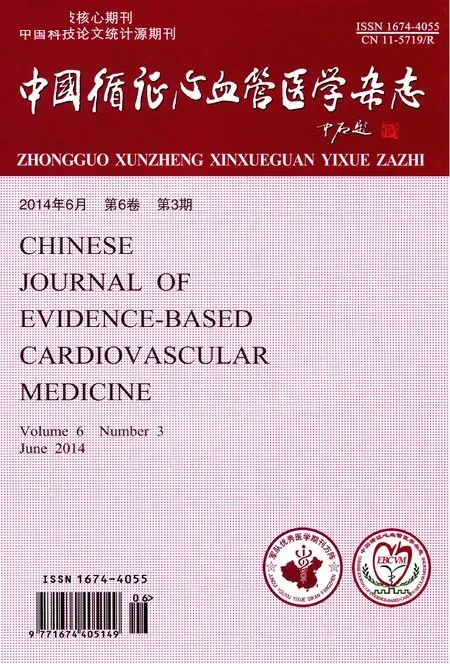Galectin-3与心力衰竭关系的研究进展
高鸿敏,高丽华
心力衰竭(heart failure,HF,心衰)是心血管疾病的终末阶段,尽管目前对心衰的诊断治疗有了很大的发展,但其发病率及死亡率仍然很高。调查发现65岁以上的患者约80%的男性及70%的女性在初次诊断心衰后的8年内死亡。因此早期识别和诊断心衰,评估高危心衰患者的近期和远期预后,针对心肌重塑的机制,积极进行治疗,防止和延缓心肌重塑的发展,从而降低心衰的死亡率和住院率是每一位医学工作者的重要责任。
脑钠肽(BNP)和血清氨基末端脑钠肽前体(NT-proBNP)是目前临床上常规用于心衰诊断、治疗的生物标志物。由于BNP/NT-proBNP血清(浆)水平受到年龄、性别、肾功能等诸多因素影响,且对心衰A期和B期无法提供早期预警,因此许多以BNP作为指导心衰治疗的靶点的许多大型临床试验研究结果(包括TIME-CHF、BATTLESCARRED和PRIMA等)并不乐观。近年研究发现半乳糖凝集素-3(Galectin-3)在心衰病理生理学方面有一定作用,是新的心衰生物标志物。本文将Galectin-3与心衰的相关临床研究做一综述。
1 半乳糖凝集素-3的特性
Galectin-3是半乳糖凝集素家族的重要成员之一,分子量大小为31 kD。文献报道,Galectin-3在巨噬细胞、嗜酸性细胞、中性粒细胞及肥大细胞中均有表达。Galectin-3主要定位于细胞质,但在细胞核和细胞表面也有表达[1,2]。Galectin-3可参与调节细胞增殖、抑制细胞凋亡,介导细胞黏附,具有参与血管形成及炎症反应等多项生物学功能[3]。既往关于Galectin-3的研究多集中在Galectin-3与甲状腺癌、结肠癌等肿瘤增殖、侵袭和转移方面[4]。2006年始,荷兰科学家注意到Galectin-3与心衰的相关性,发现Galectin-3不仅能够帮助诊断心衰,而且可以预测心衰后60天内有生命危险的患者,Galectin-3的表达对于心衰的预后评估具有重要意义[5]。2010,FDA批准了Galectin-3作为心血管疾病生物标志物的临床实验,近几年Galectin-3已成为欧美国家临床诊断和评估近期预后的新的心衰生物标志物。
2 Galectin-3 与心衰的的相关研究
2.1 Galectin-3与炎症和心肌纤维化文献报道,炎症细胞因子的级联反应对于心衰的发生、发展具有重要作用,心衰过程有持续性的全身性炎症反应[6]。文献报道,大部分炎症因子具有负性肌力作用,可以降低心肌收缩力和心输出量,促进胰岛素抵抗、内皮损伤及血液出现高凝状态等。多项研究发现Galectin-3是一种强大的促炎因子,在急性炎症反应中可刺激中性粒细胞激活和黏附,促进炎症反应。而在慢性炎症反应中可刺激单核巨噬细胞及纤维细胞的活化,促进纤维化进程[7]。
心衰的病理基础为心室重构,而心室重构的基础为心肌纤维化。Thandavarayan等[8]在左室收缩功能障碍的动物模型中发现Galectin-3的表达水平明显增高。Sharma等[9]发现Galectin-3在失代偿心衰组中表达比代偿组明显增高。多项基础研究证实Galectin-3能介导心肌中的巨噬细胞、肥大细胞浸润,增加心肌间质、血管管周纤维化及心脏胶原沉积,引起心肌肥厚、心肌顺应性减弱而导致心衰发生。
2.2 Galectin-3在心衰诊断和预后评估的临床应用2006年发表的PRIDE研究[5]首次评估了Galectin-3与心衰的关系。该研究纳入了599例因急性呼吸困难就医的患者(其中209例患者确诊为急性心衰),检测了患者血浆中NT-proBNP、Galectin-3、Apelin表达水平,评估了应用NT-proBNP、Galectin-3、Apelin诊断急性心衰、鉴别心源性呼吸困难和肺源性呼吸困难的意义。其研究结果显示,相比于NT-proBNP和Apelin,Galectin-3对于心衰预后评估具有更好的评估价值, Galectin-3是评估心衰患者60天死亡率,以及心衰再住院率的重要依据。Milting等[10]对55例需机械辅助循环(MCS)的终末期心衰患者的研究发现,血浆Galectin-3在30天的机械辅助循环治疗后无明显下降,而BNP则下降明显,提示Galectin-3与心衰的关系是非容量依赖性的。此外对于Galectin-3的检测,无论是急性心衰入院时抑或住院期间,Galectin-3的表达水平是一致的。
Galectin-3不仅可以用于心衰的诊断,而且可以预测具有心衰危险因素的人群发生心衰的风险。Lin等[11]研究发现在校正年龄、性别、吸烟 、纽约心功能分级(NYHA分级)等诸因素后,Galectin-3表达与纤维化相关生物标志物PIIINP、MMP-2具有显著的相关性,Galectin-3的表达水平可以反映心肌纤维化的发展进程。PROVE-IT TIMI22[12]研究发现ACS患者Galectin-3水平越高,其发生心衰的风险越大。Ho[13]研究发现Galectin-3可帮助预测普通人群心衰发生的风险。
临床研究发现Galectin-3对于评估心衰预后,评估心衰后再住院率、死亡率、优化治疗方案有重要意义。Shah等[14]在pride亚组研究(ADHF-Pride-Echo Substudy)中对115例因急性呼吸困难而急诊入院的患者进行了随访(其中76 例确诊为急性左心衰),检测其入院时Galectin-3水平,应用超声心动图评价心脏结构和心功能。随访4年,记录心衰再入院率及死亡率。该研究发现Galectin-3是独立于心功能的危险指标,是预测心衰明确诊断后4年内死亡率的独立危险因素,对于心衰患者的治疗方案优化具有重要指导意义。Lok等[15]在DEAL-HF研究中,对232例老年心衰患者(95%患者的心功能为NYHA Ⅲ级)进行随访,分析了心衰再入院率及死亡率。研究发现在其进行的6.5年随访中,98例患者死亡。校正了年龄、性别、严重肾功能不全等因素后,该研究结果提示Galectin-3是反映慢性心衰患者死亡风险的有意义的前瞻性预测指标。COACH研究也分析了Galectin-3表达水平与心衰患者再次因心衰入院或死亡的相关性。Boer等[16]分析了592例因心衰住院的患者的心功能、Galectin-3、BNP等表达并随访18个月,观察全因死亡率和心衰再入院率。发现Galectin-3对射血分数保留心力衰竭患者的预后评估价值优于射血分数减低心力衰竭患者。联合应用BNP及Galectin-3评估心衰预后比单独应用任意一个生物标志物的预测价值更大。Tang等[17]在类似研究中也发现心衰患者Galectin-3水平越高,预后越差。
近期公布的几个研究结果(如慢性心衰CARE Substudy研究、CORONA亚组研究)均证实Galectin-3与心衰事件的发生相关,其浓度增高提示心衰事件发作风险增高,且可增加心衰患者的全因死亡率。Galectin-3是评估慢性严重心衰患者预后及长期病死率的独立因素[18-23]。
综上所述,既往的基础与临床研究表明,Galectin-3通过参与炎症反应以及心肌纤维化等病理过程,参与了心衰的发生、发展,对预测心衰的发生、预后评估、优化治疗具有重要作用,是临床实践中与心衰的诊断和治疗密切相关的重要生物标志物。抑制Galectin-3的表达对于预防和逆转心肌纤维化可能是预防、治疗心衰的新靶点[24]。随着基础和临床研究的深入,血浆Galectin-3浓度测定很有可能作为评估心功能的一项重要补充,成为心内科一项简便易行的常规检查。
[1]Barondes SH,Cooper DNW,Gitt MA,et al. Galectins: structure and function of a large family of animal lectins[J]. J Biol Chem,1994,269(33):20807-10.
[2]Kim H,Lee J,Hyun JW,et al. Expression and immunohistochemical localization of Galectin-3 in various mouse tissues[J]. Cell Biol Int,2007,31(7):655-62.
[3]Elola MT,Wolfenstein-Todel C,Troncoso MF,et al. Galectins:matricellular glycan-binding proteins linking cell adhesion,migration, and survival[J]. Cell Mol Life Sci,2007,64(13):1679-700.
[4]Nakahara S,Oka N,Wang Y,et al. Characterization of the nuclear import pathways of Galectin-3[J]. Cancer Res,2006,66(20):9995-10006.
[5]van Kimmenade RR,Januzzi JL Jr,Ellinor PT,et al. Utility of aminoterminal pro-brain natriuretic peptide, Galectin-3, and apelin for the evaluation of patients with acute heart failure[J]. J Am Coll Cardiol,2006,48(6):1217-24.
[6]Sharma UC,Pokharel S,van Brakel TJ,et al. Galectin-3 marks activated macrophages in failure-prone hypertrophied hearts and contributes to cardiac dysfunction[J]. Circulation,2004,110(19):3121-8.
[7]Henderson NC,Mackinnon AC,Farnworth SL,et al. Galectin-3 regulates myofibroblast activation and hepatic fibrosis[J]. Proc Natl Acad Sci USA,2006,103(13):5060-5.
[8]Thandavarayan RA,Watanabe K,Ma M,et al. 14-3-3 protein regulates Ask1 signaling and protects against diabetic cardiomyopathy[J].Biochem Pharmacol,2008,75(9):1797-806.
[9]Liu YH,D'Ambrosio M,Liao TD,et al. N-acetyl-seryl-aspartyl-lysylproline prevents cardiac remodeling and dysfunction induced by Galectin-3, a mammalian adhesion/growth-regulatory lectin[J]. Am J Physiol Heart Circ Physiol,2009,296(2):H404-12.
[10]Milting H,Ellinghaus P,Seewald M,et al. Plasma biomarkers of myocardial fibrosis and remodeling in terminal heart failure patients supported by mechanical circulatory support devices[J]. J Heart Lung Transplant,2008,27(6):589-96.
[11]Lin YH,Lin LY,Wu YW,et al. The relationship between serum Galectin-3 and serum markers of cardiac extracellular matrix turnover in heart failure patients[J]. Clin Chim Acta,2009,409(1-2):96-9.
[12]Grandin EW,Jarolim P,Murphy SA,et al. Galectin-3 and the development of heart failure after acute coronary syndrome: pilot experience from PROVE IT-TIMI 22[J]. Clin Chem,2012,58(1):267-73.
[13]Ho JE,Liu C,Lyass A,et al. Galectin-3,a marker of cardiac fibrosis,predicts incident heart failure in the community[J]. J Am Coll Cardiol,2012,60(14):1249-56.
[14]Shah RV,Chen-Tournoux AA,Picard MH,et al. Galectin-3,cardiac structure and function, and long-term mortality in patients with acutely decompensated heart failure[J]. Eur J Heart Fail,2010,12(8):826-32.
[15]Lok DJ,Van Der Meer P,de la Porte PW,et al. Prognostic value of Galectin-3,a novel marker of fibrosis in patients with chronic heart failure: data from the DEAL-HF study[J]. Clin Res Cardiol,2010,99(5):323-8.
[16]de Boer RA,Lok DJ,Jaarsma T,et al. Predictive value of plasma Galectin-3 levels in heart failure with reduced and preserved ejection fraction[J]. Ann Med,2011,43(1):60-8.
[17]Tang WH,Shrestha K,Shao Z,et al. Usefulness of plasma Galectin-3 levels in systolic heart failure to predict renal insufficiency and survival[J]. Am J Cardiol,2011,108(3):385-90.
[18]Lopez-Andres N,Rossignol P,Iraqi W,et al. Association of galectin-3 and fibrosis markers with long-term cardiovascular outcomes in patients with heart failure, left ventricular dysfunction,and dyssynchrony: insights from the CARE-HF (Cardiac Resynchronization in Heart Failure)trial[J]. Eur J Heart Fail,2012,14(1):74-81.
[19]Gullestad L,Ueland T,Kjekshus J,et al. The predictive value of galectin-3 for mortality and cardiovascular events in the Controlled Rosuvastatin Multinational Trial in Heart Failure (CORONA)[J]. Am Heart J,2012,164(6):878-83.
[20]Lok DJ,Lok SI,Bruggink-Andre de la Porte PW,et al. Galectin-3 is an independent marker for ventricular remodeling and mortality in patients with chronic heart failure[J]. Clin Res Cardiol,2013,102(2):103-10.
[21]Gopal DM,Kommineni M,Ayalon N,et al. Relationship of plasma Galectin-3 to renal function in patients with heart failure: effects of clinical status, pathophysiology of heart failure, and presence or absence of heart failure[J]. J Am Heart Assoc,2012,1(5):e000760.
[22]van der Velde AR,Gullestad L,Ueland T,et al. Prognostic value of changes in galectin-3 levels over time in patients with heart failure: data from CORONA and COACH[J]. Circ Heart Fail,2013,6(2):219-22.
[23]Eurlings LW,Sanders-van Wijk S,van Kimmenade R,et al.Multimarker strategy for short-term risk assessment in patients with dyspnea in the emergency department: the MARKED (Multi mARKer Emergency Dyspnea)-risk score[J]. J Am Coll Cardiol,2012,60(17):1668-77.
[24]Yu L,Ruifrok WP,Meissner M,et al. Genetic and pharmacological inhibition of Galectin-3 prevents cardiac remodeling by interfering with myocardial fibrogenesis[J]. Circ Heart Fail,2013,6(1):107-17.

